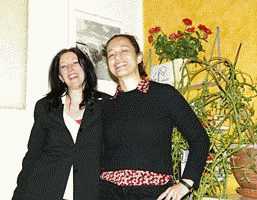AVIVA-Berlin >
Women + Work
AVIVA-BERLIN.de im Dezember 2025 -
Beitrag vom 07.04.2008

Sandra Boccia, brasilianische Marie Claire-Redakteurin, zu Besuch bei AVIVA-Berlin
AVIVA-Redaktion
Die auûenpolitische Redakteurin der "Marie Claire" in Sao Paulo/Brasilien, wurde vom Goethe-Institut und der Bundesregierung nach Berlin eingeladen. Ihre Themen: Menschenhandel...
...und die Stellung der Frau.

Im Anschluss an einen Arbeitsaufenthalt in Deutschland wurde Sandra Boccia kurzfristig von der Bundesregierung eingeladen, und ihr Programm in den 48 Stunden vom 2. ã 5. April 2008 sah etliche Stationen bei Berliner Institutionen, Organisationen und Ministerien vor. Dazu gehûÑrte unter anderem das AuswûÊrtige Amt, die Koordinations- und Beratungsstelle gegen Menschenhandel BAN YING, ein Besuch bei DIE WELT des Axel Springer Verlages, auûerdem am 02. April 2008 ein zweistû¥ndiger Zwischenstopp fû¥r ein InformationsgesprûÊch in der AVIVA-Berlin-Redaktion.
 Gemeinsam mit ihrer Dolmetscherin Luciana Dolabella, brasilianische Wahlberlinerin, diskutierte sie mit der Chefredakteurin von AVIVA-Berlin Sharon Adler und zwei ihrer Redakteurinnen, Stefanie Denkert und Silvy Pommerenke, û¥ber die Themen Sextourismus in Brasilien, internationaler Frauenhandel, Rechtsradikalismus in Deutschland, Gleichberechtigung von Frauen und û¥ber die internationalen Unterschiede der Vereinbarkeit von Familie und Beruf.
Gemeinsam mit ihrer Dolmetscherin Luciana Dolabella, brasilianische Wahlberlinerin, diskutierte sie mit der Chefredakteurin von AVIVA-Berlin Sharon Adler und zwei ihrer Redakteurinnen, Stefanie Denkert und Silvy Pommerenke, û¥ber die Themen Sextourismus in Brasilien, internationaler Frauenhandel, Rechtsradikalismus in Deutschland, Gleichberechtigung von Frauen und û¥ber die internationalen Unterschiede der Vereinbarkeit von Familie und Beruf.
 Groûes Interesse hatte Sandra Boccia an der Amadeu Antonio Stiftung und den von ihr unterstû¥tzten Projekten "EXIT" (ein Programm, das rechtsradikalen Jugendlichen den Weg aus der Neo-Nazi-Szene ermûÑglichen will) und "Lola fû¥r Lulu". Das Thema Rechtsradikalismus ist in Brasilien weitgehend unbekannt, wûÊhrend dort die Problemfelder KriminalitûÊt und die Schere zwischen Arm und Reich wesentlich brisanter sind als in Deutschland.
Groûes Interesse hatte Sandra Boccia an der Amadeu Antonio Stiftung und den von ihr unterstû¥tzten Projekten "EXIT" (ein Programm, das rechtsradikalen Jugendlichen den Weg aus der Neo-Nazi-Szene ermûÑglichen will) und "Lola fû¥r Lulu". Das Thema Rechtsradikalismus ist in Brasilien weitgehend unbekannt, wûÊhrend dort die Problemfelder KriminalitûÊt und die Schere zwischen Arm und Reich wesentlich brisanter sind als in Deutschland.
Walking the thin line on the catwalk
AVIVA-Berlin: How much attention did top models with eating disorders get from the Brazilian media? Has Marie Claire featured this topic?
Sandra Boccia: Yes, Marie Claire featured this topic in December 2006. Other magazines and newspapers from Brazil have written several articles about this subject.
AVIVA-Berlin: How did the Brazilian public (and the media) react when Ana Carolina Reston Macan, a 21-year-old top model, died from anorexia?
Sandra Boccia: We have a huge fashion event in SûÈo Paulo called "SPFW" that takes place in January and June. After the death of Ana Carolina, Paulo Borges, SPFWôÇs general director, hired a nutritionist in order to produce a fact sheet about nutrition, providing useful information to models on how to eat better and in a healthy way. CarolinaôÇs death was a huge shock and had a big impact on our society. For almost a month afterwards, we had extensive coverage in all kinds of media.
AVIVA-Berlin: Luisa Pontes, a 21-year-old ex-model from Rio, suffered from anorexia as well. She barely survived this momentous disease and commits herself now to the education about eating disorders among models. How is the Brazilian public reacting to her efforts?
Sandra Boccia: In fact, it is the first time that I hear this name. My colleague, Sandra Bittencourt, Marie ClaireôÇs fashion editor, is sitting by my side and she agrees: nobody knows who she is in the "fashion world". So, we believe her efforts havenôÇt got enough attention from the media so far. She is not known at all.
AVIVA-Berlin: Maiara Fabri, a 16-year old Brazilian top model, weighs only 98 pounds (49 kilogram) at a body height of 5ft 8ins. (1.75 metres). She obviously ignores Luisa PontesôÇ endeavours and would rather conform to the morbid beauty ideals that the fashion business dictates. Should the Brazilian government ã like the Spanish government has done - introduce a minimum weight for models in order to protect the women?
Sandra Boccia: I think it is better to give the word to Sandra Bittencourt: as far as I am concerned, she is not anorexic at all. I saw her two weeks ago and she seemed to me to have a normal weight if we consider the patterns for models. I do not consider FabriôÇs measurements as anorexic ones. The Brazilian government hasnôÇt established a minimum weight, but a minimum age (16 years old) to be allowed to work as a model in fashion shows. I do not think it is necessary to introduce this rule. For me, age is the best criteria to avoid these kinds of misunderstandings and diseases.
AVIVA-Berlin: An official guideline for fashion models could follow the classification of the World Health Organization (WHO). The latter considers a lower body mass index (BMI) of 19 as underweight - Maiara Fabri has a BMI of only 16! What is your opinion?
Sandra Boccia: Gisele Bundchen has also a BMI of 16. Sandra Bittencourt thinks that it always depends on other factors if a person is to be considered anorexic: the size of her bones, height, muscles etc. Nowadays, it is hard to say, but a model with BMI of 19 will not get some jobs. In Brazil we make a difference between "fashion models" (catwalk) and "commercial models" (advertising). The latter, in general, are older and have more "shape". ThatôÇs the way it works all over the world, not only in Brazil. I think it is important to remark that models used for "haute couture" in Paris, for example, are even thinner than Brazilians. Patterns of being fat or thin have been changing for the last decades. We think it is a trendy thing to consider someone thin as being a healthy person. Being fat is always associated with other dangerous diseases.
It is always a question of finding balance and not to sell "ideal patterns".
Marie Claire, gegrû¥ndet von Jean Prouvost, erschien erstmals 1937 in Frankreich - mittlerweile gibt es in 20 LûÊndern eigenstûÊndige Ausgaben. Neben Mode, Beauty und Gesundheit spielen seriûÑse, sozio-politische Features eine groûe Rolle in dem Frauenmagazin. Auch der brasilianischen Marie Claire liegen internationale Frauenthemen sehr am Herzen.
Weitere Infos zu Marie Claire ã Brasilien:
revistamarieclaire.globo.com